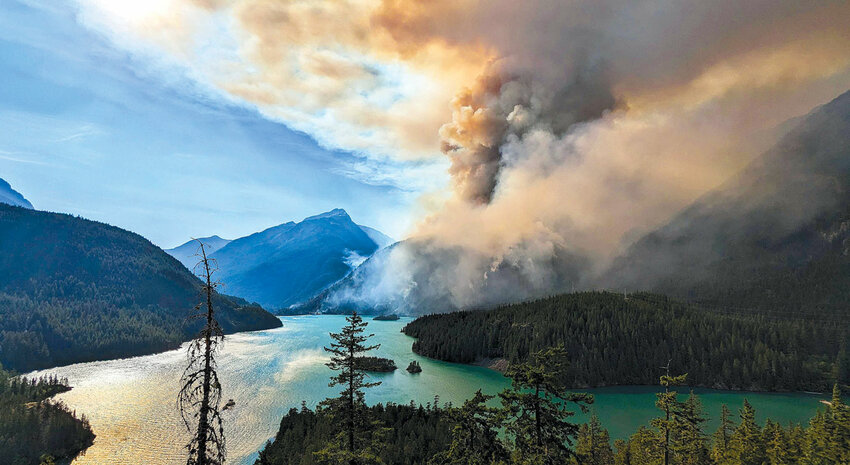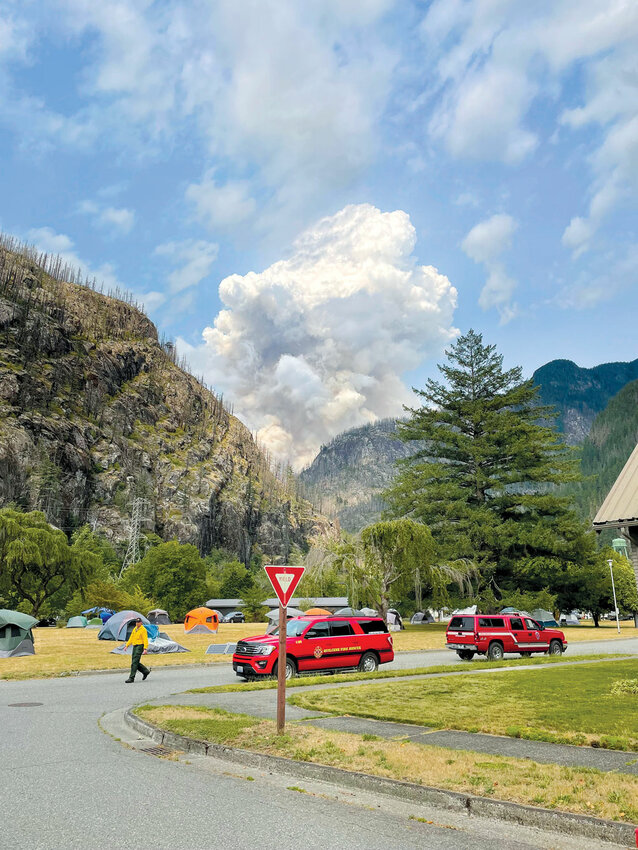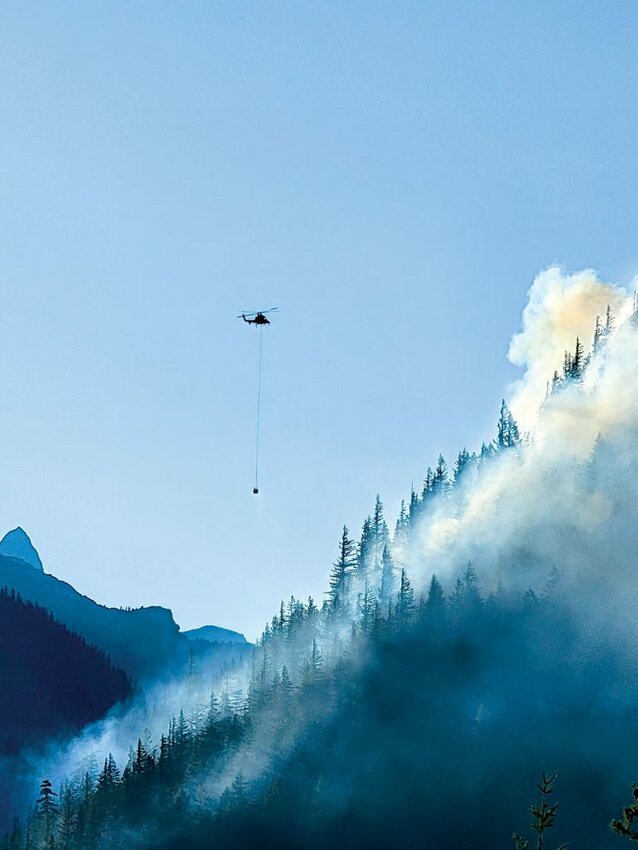 Courtesy Britt Coy, North Cascades Institute
Courtesy Britt Coy, North Cascades InstituteIn the early morning hours of July 29, a lightning bolt struck a tree in the remote slopes of Sourdough Mountain, deep in the North Cascades National Park. This mountain was similar to the many that riddle the park: craggy, remote, beautiful and full of kindling, dried out from an especially hot summer.
But Sourdough Mountain is unique in that when it lights ablaze, like it did from that fateful lightning strike, it has the chance to destroy two of the most popular lakes in the park – Diablo and Ross – two hydroelectric dams that power the city of Seattle, the town of Newhalem, and the North Cascades Institute’s (NCI) Environmental Learning Center campus.
As of the date of publication, recreation on both lakes has been closed for weeks, State Highway 20 has closed and reopened thrice, and countless trails and campsites in the park are closed, likely for the remainder of the year.
Nearly a month after it started, the Sourdough Mountain Fire has burned through over 6,000 acres of forest. Critical infrastructure like the hydroelectric dams and the town of Newhalem have been spared, but the fire looks set to continue well into September, according to updates provided by Northwest Incident Management Teams 8 and 10.
 Courtesy Northwest Incident Management Team
Courtesy Northwest Incident Management TeamA wildfire does not adhere to the invisible borders that categorize one section of the forest belonging to the National Park Service, or Seattle City Light, or the state department of transportation. It just burns the fuel ahead of it. This has forced multiple agencies across county, state and federal jurisdictions to constantly work together to manage the burn.
In December 1968, Washington state governor Daniel J. Evans created the North Cascades Reconnaissance Task Force to serve as a forum for the future development and protection of the newly minted park. It was a response to the bitter political battle that arose during the transition of the North Cascades from a national forest into a national park.
In his 1998 book “Contested Terrain,” author David Louter says the task force was needed as a level playing field for the kaleidoscope of interested parties involved in the area.
“One might think of it as Washington State’s version of the United Nations for the management of the North Cascades,” Louter wrote.
That same task force (still in existence for nearly six decades) was called into action during the Sourdough Mountain wildfire.
Representatives from firefighting crews, Seattle City Light, WSDOT, NCI, and the National Park Service have been in 24/7 contact to manage the blaze, exactly as the task force intended.
 Courtesy Tad & Darcie Lloyd, North Cascades Institute
Courtesy Tad & Darcie Lloyd, North Cascades InstituteBy July 31, just two days after the fire was first reported to authorities, “hotshot” firefighting crews from eastern Washington were called in to aid ground and air crews combatting the rapidly growing blaze.
The treacherous combination of high winds, a dry summer creating abundant fuel, and the remote location of the fire created a scenario where putting out the fire was not an option, according to Northwest Incident Management Team 10 (NWIMT10). The goal, and vocabulary, of the firefighting effort was always “containment.”
Neither NWIMT10 nor Team 8 that relieved them of their duties on August 19 expects the fire to be extinguished by their efforts alone. The fire can only be monitored and contained, “until it can be extinguished by an end-of-season event such as a significant fall or winter storm,” an August 19 NWIMT8 update stated.
“Direct intervention poses an unacceptable risk to firefighter safety.” NWIMT8 said in a press release.
By August 15, the fire had burned through 2,953 acres of forest. A total of 444 personnel were on site trying to manage the fire. With the aid of seven helicopters, 20 fire engines, and seven hand crews, NWIMT10 were able to contain 11 percent of the blaze, predominantly on the southern front that most immediately threatened SR20, the hydroelectric dams, Newhalem, and the Environmental Learning Center (ELC).
 Courtesy North Cascades National Park
Courtesy North Cascades National ParkEric Buher is program director for the North Cascades Institute, an education nonprofit organization that serves as an “outdoor classroom” for all ages of folks in the Pacific Northwest.
Buher was working in NCI’s Environmental Learning Center – a field campus inside the national park – and said his crew was monitoring the fire like they do every summer. But as this fire crept nearer to their forest sanctuary, Buher knew this one was different.
“It started to feel more intimidating,” Buher said. “Particularly because it was on the hillside directly above the access road between the dam and our space. The concern grew that it could block us in and prevent us from escaping in any way except loading everyone onto canoes.”
On August 3, NCI got the call to evacuate the center, and Buher had the job of informing the roughly 15 employees who live and work in the ELC that they were leaving, unable to say when they could return. Or if there would be anything left to return to.
“We have had to lay off some staff going into the fall,” Buher said. “Because we know that what we’re going to be able to do is not that same as it used to be. That’s been hard. We’re looking to make the best that we can out of a bad situation, but it won’t be the same fall that we had planned.”
The North Cascades Institute was founded in 1986 by a group of North Cascades National Park Rangers that wanted to drum up support for the relatively new park. Mt. Rainier has enjoyed the dedication of “National Park” since 1899, and Olympic since 1938.
NCI operated entirely out of the field until the learning center was built in 2005. In the nearly 20 years since, Christian Martin, communications director for NCI, lists avalanches, rockslides, the pandemic, and “smoke-outs” all as causes for the ELC’s past closures.
“It’s in a remote, rugged, wild place, and we’re a bit accustomed to nature having a say,” Martin said. “We’ve incorporated that into our business model and our safety and risk management.”
As of August 28, the fire continues to burn north into the alpine terrain of the park, and firefighters have established a southern front along State Highway 20. To date, the fire has consumed 6,000 acres of protected forests and has forced the closure of nearly the entire North Cascades National Park.
Never has a summer wildfire forced the closure of the ELC for the rest of the calendar year. That is, until now.
The NCI board of directors released a statement in late August announcing the closure of the learning center for the remainder of 2023, citing revenue lost during what should have been peak season, and the failure to find alternative sites on short notice.
 Courtesy Hannah Black, North Cascades Institute
Courtesy Hannah Black, North Cascades Institute“We have all these steps to carry out before we can welcome guests,” Buher said. “So even if we could go in tomorrow and start that work, we wouldn’t expect to see things operational before the middle of October. And we aren’t getting in tomorrow. We probably aren’t getting in for a while.”
Eric Buher had another tough job of calling the dozens of elementary school principals in Whatcom and Skagit counties that enroll their 4th and 5th graders into NCI’s “Mountain School.”
The school is an opportunity for kids to get out in nature and learn more about the ecosystem that they’ve grown up in, Martin said. It’s a chance to learn about the science behind climate change and how it impacts the fragile glacial ecosystem of the North Cascades. This year, however, the lesson came a bit too close to the schoolhouse.
“We’re teaching about climate change and its impacts on our planet to high school students and then we’re looking out our back door and saying, ‘there it is,’” Martin said. “ is happening now. For any of our staff and our students, it’s not a hypothetical, scientific proposition; it’s bearing down on Diablo Lake and all of the North Cascades in real time. It’s very, very scary.”
Although there won’t be any Mountain School, or famous boat tours of Ross Lake put on by Skagit Tours, or hiking the numerous trails scorched or cut off by the blaze, or enjoying campfires anywhere in the park, NCI’s program director Eric Buher still sees this as an opportunity for learning.
There are multiple species of tree residing in the North Cascades that evolved specifically to take advantage of the openings that a wildfire provides, Buher said. The metaphor isn’t lost on him.
“This is hard, and it’s painful to go through,” Buher said. “But coming out the other side, there’s opportunities for new growth and new exploration that we can do. We want to follow the forest and find that way through.” X